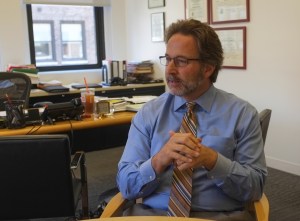Engineering Success: David Cooper on the Future of the WSP Group
By Gus Delaporte May 28, 2013 10:00 am
reprintsWhen the U.S. branch of London-based engineering consultancy WSP Group was charged by Forest City Ratner Companies and the New York Times with the task of designing the core and shell, as well as the interior, of the Grey Lady’s new headquarters on Eighth Avenue, the team faced a coterie of challenges presented by the advanced technologies required to meet the developers’ sustainability and efficiency demands.
The WSP team, led by president David Cooper, was ready for the task.

With a reputation for providing value-add efficiencies to their projects, the business formerly known as WSP Flack + Kurtz designed the building to include an underfloor air distribution system, demand-controlled ventilation and exterior sunshades. The 1.5 million-square-foot building is now one of the highest-performing green buildings in the country.
Elsewhere, WSP has been involved with many of the city’s other marquee projects, a market which demands the very best of everything, according to Mr. Cooper.
The firm’s projects in New York span commercial and residential aims, as well as sports arenas. In addition to the Times headquarters, WSP has worked on the Barclays Center and Citi Field, and is currently involved at the World Trade Center site and the development of 432 Park Avenue, which will be the tallest residential building in the Western Hemisphere.
“We are doing many of the signature projects in New York,” Mr. Cooper said. “Our structures business is doing work at the World Trade Center site; we’ve worked at the New York Times headquarters; we’re working on what will be the tallest residential building at 432 Park. New York wants the best—the best of everything.”
Late last month, London-based WSP Group announced that the four businesses that have comprised a U.S. presence for the global firm since 2000—WSP Cantor Seinuk, WSP Flack + Kurtz, WSP Environment & Energy and WSP SELLS—would begin operating as a fully integrated firm, with Mr. Cooper acting as president and chief executive officer.
The belief is that such a combination will provide clients with greater value. The plan is to now expand the business, which while technically strong, according to Mr. Cooper, is still relatively small in the market. The goal is to ultimately fill a gap in the market with a pure, multidisciplinary engineering consultancy that feels like a boutique firm.
It was a plan that had been in the works for some time, though the process slowed at the bottom of the market. For four years, the leadership of the separate businesses had been working together as an executive committee, learning each respective business line, figuring out market synergies and building common infrastructure, including an IT backbone, setting the stage for integration.
Where will the newly integrated WSP business be in five to 10 years? In addition to taking on traditional commercial and residential projects with an enhanced staff, officials also want to pursue design-build and public-private partnership projects, which although popular in Canada, Europe and Australia have yet to truly take hold in the United States. The lack of public funding, however, will necessitate more private investment in infrastructure projects, Mr. Cooper said.
Across the United States, WSP employs 1,050–600 in the buildings business–with much of the activity focused on the Mid-Atlantic and the Northeast, but with a growing influence farther west: offices were opened in Las Vegas and Seattle in 2011.
Though Mr. Cooper now oversees the entire product line, separated into three business areas—buildings, transportation and infrastructure, environmental—he admits the buildings business of the former Flack + Kurtz is still closest to him.
“That’s my affinity,” he said. “But I’m very much focused on the broader business and driving the synergies.”
Sustainability plays an important role in Mr. Cooper’s work at WSP. He admits, however, that it was only recently that firms began getting value out of their investment in efficiency, and that the movement may have been accelerated had developers seen what value could be achieved by prioritizing sustainable practices.
“They’re throwing money at it just to say ‘we’re sustainable,’ and not necessarily getting value out of it,” he said. “I call it pragmatic sustainability, there has to be a financial basis to it.”



